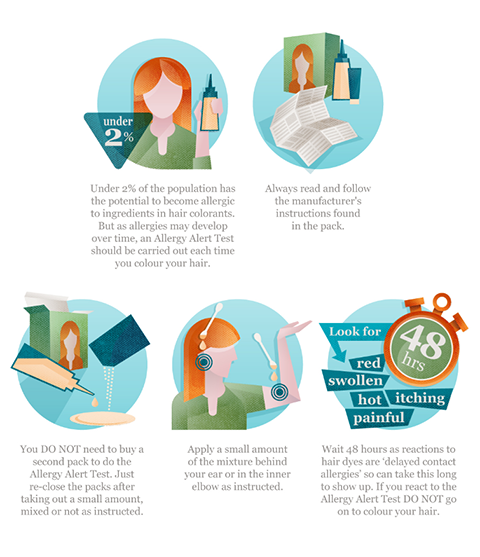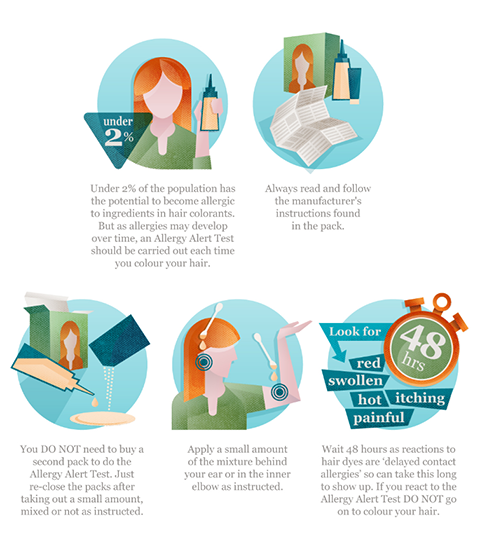Table Of Content

The use of henna dates back to ancient Egypt, while the ancient Greeks used to bleach their hair with lye, pollen, and yellow flower petals and the Romans would dye their hair black with walnut extracts. Reactions to PPD can range from mild irritation in the scalp to an allergic reaction that can potentially trigger serious symptoms throughout the body. You could also have a patch test done at an allergy clinic, to see which chemicals you're sensitive to, if any. You can then check product labels and avoid products containing these chemicals.
Allergic reactions to hair dye chemical PPD are common but treatable - Business Insider
Allergic reactions to hair dye chemical PPD are common but treatable.
Posted: Thu, 08 Aug 2019 07:00:00 GMT [source]
How Often Do Hair Dyes Cause An Allergic Reaction?
A pharmacist or GP will be able to recommend an antihistamine for you. Hair dyes containing PPD are safe to use, providing safety instructions are followed. These products are strictly regulated and there's a maximum limit to the amount of PPD the product can contain.
Permanent Hair Dyes Without PPD, Ammonia, and Peroxides?
The list of possible irritants can then be checked against the ingredients of hair dyes to find the best one for their use. The PPD is usually mixed with peroxide in the dye to alter the hair color. What happens before this reaction is fully complete also makes the PPD more likely to interact with the skin and cause an allergic reaction. ‘’In rare cases, hair dyes can cause anaphylaxis, which is a fatal allergic reaction. Its symptoms include dizziness, nausea, swelling of limbs, eyes, lips, or tongue, raised bumps on the skin, confusion, and a drop in blood pressure,’’ says Dr. Zeel. While in some cases, your hair stylist may tell you that it's absolutely normal to feel skin and eye burning during hair color treatments, do not ignore these symptoms.

What are the complications of contact reaction to cosmetics?
The product is also 100% ammonia-free and made with plant extracts that make it gentle for sensitive scalps if you want to cover gray roots. What you need to do is eliminate as many toxic ingredients as possible and find products that pose the lesser risk. Then patch test to confirm and validate which ones will work for you. Beet juice, carrot juice, coffee, lemon juice, sage, and chamomile tea are nature’s superstars for coloring your hair naturally. For instance, a coffee mask for dark brown hair will enhance the vibrant dark hues. If you don’t see an improvement in symptoms or experience severe ones, visit your doctor immediately.
How Long to Leave Hair Dye in
Symptoms of a dye allergy range from typical contact dermatitis, like rashes and itchiness, to potentially life-threatening anaphylactic shock. The ingredient in hair dyes most often responsible for a reaction is para-phenylenediamine (PPD), which is used in many permanent or oxidative dyes to darken hair or cover grey hair. Reactions can also occur to a similar hair dye known as PTD (para-toluenediamine). Although there are many PPD-free hair coloring alternatives available, there may be fewer color selections. They either contain no PPD at all or PPD-related compounds such as hydroxyethyl-p-phenylenediamine sulfate (HPPS) that stain hair by penetrating it deeply.
The Role of PPD in Hair Dye Allergy
Symptoms may include hives, swelling of the face and airways, shortness of breath, and a drop in blood pressure with a fast heart rate and possibly loss of consciousness. Anaphylactic shock can be fatal, and anyone experiencing these symptoms needs immediate medical attention. Other choices can include indigo and vegetable-based dyes and semi-permanent dyes that have been certified by an independent laboratory to be free of chemical additives. Some alternate names for PPD are PPDA, 1,4-benzenediamine, 4-aminoaniline, p-diaminobenzene, and phenylenediamine base. After application, wash your hands with soap to remove any hair dye residue that might have gotten into your skin.

The FDA often receives questions about the safety and regulation of hair dyes. Most of these products belong to a category called “coal-tar” hair dyes. For the purpose of this article, the terms ‘hair dyes’ and ‘hair colorants’ will both be used. The product does not contain ammonia, making it ideal for people with sensitive scalps.
Why You Should Do the Hair Dye Allergy Patch Test - At-Home Hair Color Tips - Good Housekeeping
Why You Should Do the Hair Dye Allergy Patch Test - At-Home Hair Color Tips.
Posted: Mon, 20 Jul 2015 07:00:00 GMT [source]
If you want to temporarily cover your gray hair, but have a PPD allergy, then Herbatint’s 100% organic, plant-based henna hair dye is an excellent choice. During most severe reactions, people experience dizziness, trouble breathing, as well as nausea. Information on hair dye allergy and the best steps to take when dying your hair.
Applying hair dye to the hair will inevitably transfer to the scalp. An overwhelming feeling of itching and burning is one of the most common reactions many women with sensitive skin may experience. Some people may only experience skin irritation while for some others, it may get more serious. Contact dermatitis is not an uncommon symptom of this allergic reaction.
However, the evidence regarding the carcinogenicity of hair dye components in humans remains inconclusive, necessitating further research. It is important not to leave hair dye in for longer than recommended. While most chemicals in hair dye are considered safe to use, leaving the chemicals on the scalp for too long can be irritating for most people.
Avoiding further use of the product is key to preventing the recurrence of an allergic reaction. Most contact dermatitis from a hair dye allergy is classified as type 4 hypersensitivity, and it usually takes hours or more for symptoms to occur upon exposure. Some people also get contact allergic dermatitis or other symptoms from ingredients such as ammonia, resorcinol, and peroxide. Nearly 60% of people allergic to PPD can reportedly tolerate PTDS hair dyes.
This condition can lead to persistent itching, redness, and skin thickening in the affected areas. In a London retrospective survey, positive reactions to PPD on patch testing doubled over six years, reaching 7.1% in an adult contact dermatitis clinic. This increase in prevalence cannot be attributed solely to occupational exposure, medicolegal claims, or temporary "henna" tattoos containing high concentrations of PPD.
Other than PPD, many other chemical agents are used for the two components. We did not patch test these agents in our study and that might have been responsible for negative patch test results in 26 of our patients. Unavailability of hair dye allergens other than PPD, the small number of patients, and not testing with patient's own hair colorant or other cosmetics may have resulted in our missing some cases of compound allergy. Clinically, hair dye dermatitis can present as both irritant dermatitis and allergic contact dermatitis. It may also cause severe clinical contact reactions ranging from anaphylaxis to oedema of the scalp, face, and eyelids.
Moreover, no peroxide, synthetic dyes, sulfates, or parabens make this root touch-up product a suitable option for allergy-prone people. People allergic to PPD can have peace of mind knowing that none of it or its derivatives are used to make the dye stick to the hair. The 100% USDA-organic seal makes Herbatint a safe product that can be used in the comfort of your home. Being part of the many natural ingredients known to color hair, henna doesn’t cause an itchy scalp or swelling of the hair shafts.
If you’re allergic to hair dye, your symptoms can range from mild to serious. Most cases of allergic contact dermatitis stemming from exposure to hair dye are caused by an ingredient called paraphenylenediamine (PPD). So avoid them if you are sensitive to contact dermatitis or allergens. If you start experiencing a severe allergic reaction instantly while dyeing your hair, you need to rush to a hospital and seek medical help immediately. Doctors may give you an adrenaline injection to control the reaction quickly. B. You can also take oral antihistamines like Benadryl to reduce skin inflammation caused due to hair dye allergy.

No comments:
Post a Comment